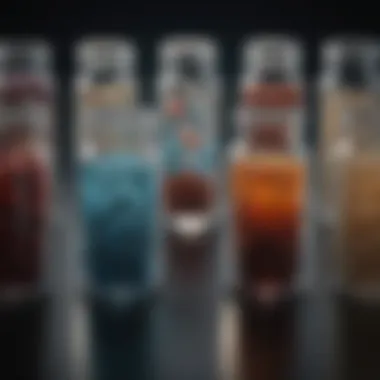Microbial Inoculants: Impact on Agriculture and Sustainability


Intro
Microbial inoculants represent a significant advancement in agricultural science, enabling enhanced soil health and sustainable farming practices. This guide will delve into the diverse types of microbial inoculants on the market, their utility in agriculture, and their broader implications for environmental sustainability. It will also address key considerations for purchasing these products.
Background and Context
Overview of the Research Topic
The emergence of microbial inoculants has transformed our understanding of soil ecosystems. These products, made up of live microorganisms, play an essential role in promoting plant growth and improving nutrient availability. They can include bacteria, fungi, and other microorganisms tailored to enhance specific agricultural practices.
Historical Significance
Historically, the concept of utilizing microbes in agriculture dates back centuries, although it has gained momentum in recent decades with advancements in biological sciences. The shift from chemical fertilizers to microbial alternatives stems from increasing awareness of sustainable practices and the need for soil revitalization. Research has shown that microbial inoculants can effectively restore soil structure and enhance microbial diversity, addressing long-term agricultural challenges.
Key Findings and Discussion
Major Results of the Study
Microbial inoculants provide numerous benefits, including improved soil fertility, increased plant resilience, and reduced reliance on synthetic chemicals. Key findings indicate that these products can significantly enhance crop yields, especially in marginal soils. For instance, bacteria like Azospirillum and Rhizobium have demonstrated superior nitrogen-fixing capabilities, essential for sustainable agriculture.
Detailed Analysis of Findings
- Soil Health: Research indicates that microbial inoculants increase soil organic matter and improve soil structure. This, in turn, promotes better water retention and aeration.
- Crop Productivity: Application of microbial products can lead to measurable increases in crop yield. Studies suggest an up to 30% improvement in vegetable production when using specific inoculants.
- Environmental Impact: Their use can decrease the environmental footprint of agriculture by reducing the need for chemical fertilizers. It aligns with goals in sustainable agriculture to minimize chemicals and maximize biological activity in the soil.
"The integration of microbial inoculants in farming not only helps in enhancing productivity but also contributes to the ecological balance."
Considerations for selecting microbial inoculants should include understanding the specific microorganisms involved, their compatibility with existing agricultural practices, and the intended outcomes for soil health and crop production.
Understanding Microbial Inoculants
Microbial inoculants play a critical role in modern agriculture, enhancing soil health and plant productivity. They consist of live microorganisms, which are applied to the soil or plants to improve growth, nutrient availability, and disease resistance. Understanding these inoculants is vital for farmers, researchers, and professionals involved in agriculture. They offer numerous benefits, including promoting sustainability and reducing reliance on chemical fertilizers.
Definition of Microbial Inoculants
Microbial inoculants are defined as preparations containing living microorganisms, such as bacteria, fungi, or yeasts. They are designed to be applied to crops, soil, or seeds to enhance biological processes related to plant growth. These microorganisms can form beneficial relationships with plant roots, improving the uptake of nutrients such as nitrogen and phosphorus. Inoculants may also augment the microbial diversity of the soil, contributing to overall soil health. It is essential to appreciate that not all microbial products are considered inoculants; the effectiveness of the product largely depends on the specific microorganisms used and how they are applied.
Historical Context and Development
The use of microbial inoculants is not a new concept. Historically, various cultures have utilized natural methods of soil amendment, including composting and fermentation, which promote beneficial microorganisms.
In the early 20th century, research began to formalize the use of specific microbial strains as agricultural treatments. The advent of biotechnology in the latter part of the century led to significant advancements in the cultivation and application of these organisms. This encouraged the precise selection of microbes based on their specific beneficial traits. For example, Rhizobium species are well known for their ability to fix atmospheric nitrogen in legumes, which has been utilized for decades to improve soil fertility. Today, the market for microbial inoculants continues to expand, driven by ongoing research and an increasing interest in sustainable agricultural practices.
"The effectiveness of microbial inoculants can vary greatly based on environmental conditions, which highlights the need for ongoing research and adaptation in agricultural practices."
In summary, understanding microbial inoculants is essential for leveraging their benefits in agriculture. Definitions and historical developments provide a foundation for comprehending their role in enhancing soil health and crop productivity.
Types of Microbial Inoculants
Understanding the types of microbial inoculants is essential. Each type serves unique roles in enhancing soil and plant health, and they can significantly impact agricultural productivity. Through different mechanisms, these inoculants provide distinct benefits such as nutrient cycling, disease resistance, and enhanced plant growth. The key types — bacterial, fungal, and yeast inoculants — have specific characteristics and applications, making it vital for users to select the right type for their needs.
Bacterial Inoculants
Bacterial inoculants are among the most commonly used microbial products in agriculture. They primarily consist of beneficial bacteria that promote plant growth by enhancing nutrient availability. For instance, species such as Rhizobium can fix atmospheric nitrogen, making it accessible to plants. This is important for crops like legumes, which thrive on nitrogen-rich soils.
Benefits of Bacterial Inoculants:
- Nitrogen Fixation: They improve soil nitrogen levels, which is crucial for plant development.
- Nutrient Solubilization: Certain bacteria make phosphorus more available to plants, aiding their growth.
- Disease Suppression: Some bacterial strains can combat pathogenic microbes, helping to protect crops.
Bacterial inoculants are often used in seed treatments or applied directly to the soil. Their effectiveness can depend on environmental factors such as soil pH and moisture. Proper application rates and techniques should be considered for optimal results.
Fungal Inoculants
Fungal inoculants play a fundamental role in soil health and plant vitality. They often include mycorrhizal fungi, which establish symbiotic relationships with plant roots. This relationship improves water and nutrient uptake significantly.
Advantages of Fungal Inoculants:
- Enhanced Nutrient Uptake: Mycorrhizae extend root systems, helping plants acquire phosphorus, potassium, and micronutrients.
- Soil Structure Improvement: Fungi contribute to soil aggregation, improving aeration and water retention.
- Resistance to Stress: They can help plants withstand drought and other stressful conditions.


The application of fungal inoculants generally involves mixing the product with soil or seed. Timing and method of application influence their establishment and performance. Understanding the specific needs of the crop and its growing conditions is key.
Yeast Inoculants
Yeast inoculants, while less common than bacteria and fungi, have gained attention for their potential benefits. These microorganisms can assist in various processes, including fermentation and nutrient recycling within the soil environment.
Key Benefits of Yeast Inoculants:
- Improved Soil Microbial Activity: Yeasts can enhance overall soil microbial health, promoting a balanced ecosystem.
- Nutritional Supplementation: They can contribute to the bioavailability of certain nutrients, benefiting overall plant growth.
- Plant Growth Promotion: Some yeast strains release phytohormones, which help in regulating plant growth and development.
Yeast inoculants are often used in conjunction with other microbial products to enhance their effectiveness. Their role can be particularly valuable in organic farming systems where traditional chemical fertilizers are limited. Choosing the right type of yeast and understanding its compatibility with other inputs is crucial.
Understanding the types of microbial inoculants is key to successful agricultural practices.
Selecting the appropriate microbial inoculant type can significantly affect agricultural outcomes. This choice requires evaluating specific crop requirements, soil conditions, and the desired benefits. The interaction between various microbial types can also lead to synergistic effects, emphasizing the importance of thoughtful selection.
Benefits of Microbial Inoculants
Microbial inoculants offer significant advantages in the realm of agriculture and soil health. Their benefits are manifold, impacting everything from soil fertility enhancement to environmental sustainability. Understanding these advantages is essential in recognizing why various stakeholders, including farmers, agricultural researchers, and environmentalists, are investing in these probiotics for the soil. This section delineates the primary benefits, supporting the notion that microbial inoculants are integral to modern agricultural practices.
Enhancement of Soil Fertility
Soil fertility is a critical factor in agricultural productivity. Microbial inoculants contribute positively to soil fertility by increasing nutrient availability. They work through various mechanisms, including nitrogen fixation, decomposition of organic material, and nutrient solubilization. For instance, certain bacteria can convert atmospheric nitrogen into forms that plants can use. This process is vital in areas where soil nitrogen is limited.
Additionally, microbial agents help in breaking down complex organic matter, releasing nutrients bound within it. This action enhances the nutrient profile of the soil, making it more beneficial for plants. Regular use of microbial inoculants leads to improved soil structure, moisture retention, and overall soil health, contributing to a sustainable agricultural system.
Promotion of Plant Growth
The promotion of plant growth is another key benefit of microbial inoculants. These agents not only support nutrient uptake but also produce growth-promoting substances. Substances like auxins, cytokinins, and gibberellins enhance root development and stimulate shoot growth. Consequently, plants treated with microbial inoculants exhibit improved vigor and resilience.
Research has shown that specific strains of bacteria can improve seed germination rates and promote stronger plant root systems. This results in healthier plants capable of accessing water and nutrients more effectively. In turn, this can lead to higher yields and improved crop quality across diverse agricultural settings.
Suppression of Soil-borne Diseases
Soil-borne diseases pose a significant threat to crops worldwide. Microbial inoculants can play a role in disease suppression through various biological mechanisms. Beneficial microorganisms can outcompete pathogenic strains for resources and space, reducing their prevalence in the soil. Moreover, some microbial inoculants produce metabolites that inhibit the growth of harmful pathogens.
For example, certain fungal inoculants can enhance plant defenses, making crops more resilient to disease. By incorporating these inoculants, farmers can decrease reliance on chemical fungicides, which may have long-term side effects on soil health and biodiversity.
Environmental Impact and Sustainability
The role of microbial inoculants extends beyond agriculture; they are crucial for environmental sustainability. By promoting healthier soils and reducing chemical inputs, these inoculants contribute to a more sustainable agricultural system. They reduce the risk of pollution from runoff caused by fertilizers and pesticides.
Moreover, microbial inoculants can also play a role in carbon sequestration. Healthier soils, rich in microbial life, can capture and store carbon dioxide, mitigating climate change impacts. For this reason, microbial inoculants are not merely tools for enhancing crop production but crucial components in fostering sustainable agricultural practices.
"Microbial inoculants bridge the gap between traditional farming and sustainability, promoting health in both soil and crops."
Overall, the benefits of microbial inoculants in agriculture highlight their importance as a pivotal resource for enhancing soil fertility, promoting plant growth, suppressing diseases, and fostering environmental sustainability. As agricultural practices evolve, the incorporation of microbial inoculants presents a scientifically sound, sustainable approach to farming.
Applications in Agriculture
Microbial inoculants have become a vital component in modern agriculture. Their application holds significant promise for enhancing the productivity and sustainability of farming systems. By improving soil health and plant growth, these inoculants help farmers optimize inputs and manage challenges that arise from environmental stressors.
Use in Crop Production
In crop production, microbial inoculants play a key role. The introduction of beneficial microbes can promote nutrient uptake, enhance root development, and improve overall plant vigor. For instance, certain bacterial strains are known to fix nitrogen, making it more available to plants. This reduces the need for synthetic fertilizers, which can be costly and environmentally damaging.
Regular application of these inoculants can also lead to an increase in yield size and quality. Studies show crops such as corn and wheat respond positively to microbial treatments, often resulting in healthier plants. However, it is important to choose the right inoculant according to the specific crop needs to achieve the best results.
"Using microbial inoculants can lead to sustainable farming practices while enhancing food security."
Soil Amendment Practices
Soil amendment is another area where microbial inoculants demonstrate their usefulness. The inclusion of these microbes can enhance the organic matter content in the soil and improve soil structure. This results in better water retention and aeration, crucial for healthy root systems. Furthermore, microbial communities contribute to the decomposition of organic materials, thereby releasing nutrients back into the soil.
Inoculant application as a soil amendment can simultaneously address problems of erosion and nutrient loss, which are common in conventional farming practices. Adopting microbial approaches can lead to improved soil fertility over time, creating a more resilient farming system.
Integration with Agroecological Practices
Integrating microbial inoculants with agroecological practices paves the way for sustainable agriculture. This method considers various species interactions and promotes biodiversity, which can, in turn, lead to healthier ecosystems. Using microbial inoculants alongside crop rotation, cover cropping, and reduced tillage is an effective way to leverage microbial benefits.


Such practices not only enhance soil microbial diversity but also protect against pest and disease outbreaks. Healthy soil leads to resilient cropland, capable of withstanding adverse weather conditions. The synergy achieved when microbial inoculants are used in combination with agroecological practices can significantly contribute to sustainable food production systems.
Market Overview: Microbial Inoculants for Sale
The market for microbial inoculants is expanding. Understanding this market is vital for stakeholders, including farmers, researchers, and businesses involved in agricultural solutions. This section delves into current market trends, key players, and pricing strategies of microbial inoculants. Awareness of these aspects can help in making informed decisions regarding the procurement and application of these biological products.
Current Market Trends
Recent trends indicate a significant growth trajectory in microbial inoculants. The increasing demand for sustainable agricultural practices is pushing the market forward. Researchers are discovering the potential of microbial products to enhance soil health and crop yield. More farms are adopting these products, underscoring a shift from traditional chemical fertilizers to bio-based solutions.
- Sustainable Practices: Farmers are looking for alternatives to synthetic fertilizers, leading to an increase in microbial inoculant usage.
- Innovation in Products: Companies are investing in R&D to develop advanced formulations that are more effective.
- Consumer Awareness: There is a growing public interest in organic and sustainably grown produce, influencing farmers to adapt their practices.
In summary, the move towards agricultural sustainability, innovation in microbial technologies, and rising consumer awareness are the pillars shaping current market trends.
Key Players in the Market
The microbial inoculant market has several players, each contributing to its development. Notable companies include:
- Bayer CropScience: They focus on integrated solutions that combine microbial products with other tools for enhancing productivity.
- Novozymes: Recognized for their innovations in enzymes and microbial technologies, Novozymes supplies a range of bio-solutions to improve crop health.
- BASF: Their expertise in chemical products complements their microbial offerings, making them a key player in both markets.
These companies are not only engaged in production but also in educating farmers about the benefits of microbial inoculants, fostering wider acceptance.
Pricing Strategies
Pricing of microbial inoculants can vary significantly based on several factors. Understanding these elements is crucial for buyers. Key factors influencing pricing include:
- Type of Inoculant: Bacterial, fungal, or yeast inoculants each have different price points based on their production costs and efficacy.
- Packaging Size: Bulk purchases often offer a lower cost per unit compared to smaller packages.
- Market Demand: The increasing popularity may drive prices up, especially during peak planting seasons.
"Investors should consider the cost per benefit received, rather than just focusing on initial price."
To navigate pricing effectively, buyers must evaluate the overall value rather than just the upfront cost.
Considerations for Purchasing Microbial Inoculants
When looking to purchase microbial inoculants, several vital considerations must inform your decision. This section delves into those elements essential for ensuring efficacy, safety, and regulation compliance. Buyers must approach their selections with a thorough understanding of the product's quality, the specific applications for use, and the existing regulatory frameworks that govern these biological products.
Quality Assessment
Quality is paramount when selecting microbial inoculants. The performance of these products can vary significantly based on the microorganisms' strains used, the preparation methods, and the formulation.
A robust quality assessment involves several factors:
- Microbial Viability: Ensure that the inoculants contain live microorganisms in sufficient numbers. The viability affects the product's effectiveness.
- Purity Levels: Products must be free from unwanted contaminants, which could diminish their performance or pose risks to the environment and human health.
- Labeling Accuracy: Labels should provide accurate information regarding the species and strains of microorganisms present, including shelf life and recommended storage conditions.
Companies that prioritize transparency and robust quality control measures tend to stand out in the market. Research and third-party verification of the inoculant's claims can also enhance buyer confidence.
Appropriate Selection for Specific Applications
Selecting the correct microbial inoculant must align with the intended application. Not every product suits every agricultural method or crop type.
Factors to consider include:
- Crop Requirements: Different plants have unique microbial needs. Research which inoculants are designed for specific crops, such as legumes requiring nitrogen-fixing bacteria.
- Soil Conditions: Factors like pH, moisture levels, and nutrient availability impact which microorganisms will thrive and be effective.
- Integration with Other Inputs: Understand how microbial inoculants will interact with other fertilizers or amendments used in your agricultural practices.
Taking the time to match the right product to specific goals can lead to improved outcomes.
Regulatory and Compliance Issues
Investors and agricultural professionals must be aware of the regulatory landscape surrounding microbial inoculants. Compliance is necessary to ensure product safety and efficacy.
Consider the following:
- Registration Requirements: Depending on the region, some inoculants must be registered with agricultural authorities. This process determines if products meet specified safety and effectiveness standards.
- Label Regulations: Labels must comply with national regulations, clearly outlining usage instructions, safety information, and environmental considerations.
- Environmental Impact Assessments: In some jurisdictions, microbial products may need an assessment to evaluate their potential impacts on local ecosystems.
It is essential to remain informed about evolving regulations to ensure continuous compliance and safeguard agricultural practices.
Overall, recognizing these key considerations will enhance your ability to purchase microbial inoculants that are not only effective but also safe and compliant with existing regulations.
Case Studies of Successful Applications


The section on case studies of microbial inoculants is crucial as it showcases real-world applications and outcomes. By examining specific instances where microbial inoculants have been utilized, readers gain insights into their practical effectiveness, suitability across various conditions, and overall impact on agricultural and environmental performance. These case studies can illuminate various aspects such as the methodology used, the specific strains employed, and the results observed, thus providing a comprehensive understanding of how microbial inoculants perform in different scenarios. The information derived from these studies serves as a valuable reference point for those contemplating their use in similar contexts.
Field Trials in Crop Production
Field trials represent a systematic investigation into how microbial inoculants influence crop production under natural conditions. These trials often involve controlled experimentation, comparing treatments with microbial inoculants to untreated controls. The results have shown promising improvements in yield, soil health, and pest resistance. For example, a recent trial with Rhizobium inoculants in soybean cultivation revealed significant gains in nodulation and nitrogen fixation, resulting in increased plant biomass and higher grain yields. Such evidence underscores the functional benefits of integrating microbial inoculants into agricultural practices.
Moreover, field trials are not merely limited to individual crop types. They have been conducted across various crops, including cereals, legumes, and fruit-bearing plants. The adaptability of microbial inoculants to different crop systems is pivotal in establishing their viability as a standard practice in sustainable agriculture.
Success Stories from Organic Farming
Organic farming has embraced microbial inoculants as part of its ecologically-friendly approach. Numerous success stories highlight the synergistic effects of combining organic practices with microbial technologies. Farmers report better soil structure, enhanced nutrient uptake, and reduced dependence on chemical fertilizers.
For instance, a vegetable farm in California implemented a blend of fungal and bacterial inoculants. The results were remarkable, with increased soil fertility and enhanced resilience against disease outbreaks. Crop rotation combined with microbial applications not only improved yield but also allowed the farmer to reduce tillage practices, further contributing to soil health and biodiversity.
These anecdotes emphasize that the integration of microbial inoculants can lead to significant agricultural advancements. Adopting these practices supports both economic viability and ecological sustainability, making them valuable case studies for future exploration and application in organic farming over a wider scale.
Challenges and Limitations
The exploration of microbial inoculants is incomplete without addressing the challenges and limitations impacting their use. Understanding these elements is crucial for anyone engaged in agricultural practices or microbial research. They not only inform purchasing decisions but also guide the use of these substances in practice.
Variability in Microbial Effectiveness
One of the most significant challenges is the variability in the effectiveness of microbial inoculants. Different strains of microbes may exhibit distinct responses under varying environmental conditions. Factors such as soil type, moisture levels, and climate can alter the performance of these inoculants.
Some research indicates that a specific inoculant may enhance plant growth in one setting but fail to do so in another. This inconsistency calls for thorough field trials and research to ascertain which microbial inoculants are effective under specific scenarios. As a result, it becomes essential to consider the local context when selecting these products for agricultural application.
Potential Negative Interactions with Other Inputs
Another limitation arises from the potential negative interactions that microbial inoculants may have with other agricultural inputs. Fertilizers, pesticides, and herbicides can affect the viability and effectiveness of the microbes they aim to support. For instance, certain chemical fertilizers may create an environment that is inhospitable for beneficial bacteria, reducing their efficacy.
Thus, farmers should be cautious and conduct a comprehensive review of how microbial inoculants interact with their existing management practices. Integration of these inoculants must be approached with an understanding of how they coexist with other agricultural inputs, ensuring that the overall productivity of crops is not compromised.
Scaling Production and Distribution
Lastly, scaling production and distribution of microbial inoculants presents another challenge. Developing effective and reliable production processes requires investment in technology and facilities. Small or medium-sized agricultural businesses might find the initial costs prohibitive.
Moreover, ensuring the inoculants remain viable during transportation and storage is complex. Temperature fluctuations and humidity can significantly affect the viability of microbial products. This factor complicates distribution, especially when targeting areas far removed from production sites.
Future Directions in Research
Research on microbial inoculants is evolving rapidly, opening pathways for innovation that can significantly change agricultural practices and environmental sustainability. Understanding the future directions in this field is crucial for stakeholders, including farmers, scientists, and policymakers. With growing concerns about food security and ecological balance, focused research can drive the development of more effective and accessible microbial inoculants.
Innovations in Microbial Technology
The future of microbial inoculants is closely tied to innovations in technology. Techniques such as bioinformatics and advanced genomic studies are being employed to identify specific microbial strains that can offer tailored solutions to agricultural challenges. For instance, researchers are now focusing on isolated bacteria that can specifically target nutrient deficiencies in soil, ensuring plants receive the essential elements they require.
Furthermore, advancements in encapsulation and formulation techniques may increase the shelf life and effectiveness of these inoculants. The application of nanotechnology could also enhance the delivery of microbes to plants. This approach ensures that beneficial microorganisms have maximum contact with plant roots, increasing their efficacy in promoting growth and soil health. These technological advancements are crucial for making microbial inoculants more reliable and effective.
Potential for Genetic Engineering Applications
The potential for genetic engineering applications in microbial inoculants is another area of significant interest. Scientists are exploring ways to modify microbial genomes to enhance specific traits that could improve their performance. For instance, genetically engineered strains of Rhizobium could be designed to fix nitrogen more efficiently, supporting plant growth in nitrogen-deficient soils.
However, this path raises important ethical and regulatory considerations. The acceptance of genetically modified organisms varies by region, and public perception can influence market demand. Research must therefore include studies on consumer attitudes towards genetically engineered microbial inoculants, ensuring that any advancements align with market needs and ecological integrity.
Role of Microbial Inoculants in Climate Change Mitigation
Microbial inoculants have a critical role to play in climate change mitigation strategies. As agriculture is a significant contributor to greenhouse gas emissions, incorporating microbial technologies can help reduce the carbon footprint of farming practices. These inoculants can enhance soil carbon sequestration by promoting microbial processes that store carbon in organic forms.
Additionally, specific microbial strains can help plants cope with abiotic stressors, such as drought or salinity. By improving plant resilience, microbial inoculants can aid in maintaining crop yields under changing climate conditions. This not only ensures food production but also supports efforts to promote sustainable agricultural systems.
"The integration of microbial technology in agriculture represents not just a leap in efficacy, but a fundamental shift towards sustainability in our farming practices."
Culmination
In summarizing the multifaceted topic of microbial inoculants, it is clear that these biological agents play a crucial role in modern agriculture. Their ability to enhance soil health, bolster plant growth, and promote sustainable agricultural practices stands out. Various types of microbial inoculants, including bacterial, fungal, and yeast variants, each offer unique benefits that contribute to fundamental shifts in cropping systems.
The benefits are not limited to agricultural productivity. Microbial inoculants also offer environmental advantages. They can reduce reliance on chemical fertilizers and pesticides, leading to less environmental pollution and a more sustainable farming model. In addressing issues such as soil-borne diseases and nutrient deficiencies, these products emerge as a vital tool for long-term ecological balance.
However, successful implementation also depends on understanding purchasing considerations. Quality assessment, appropriate application, and compliance with regulatory standards are paramount. Consumers must weigh these factors carefully to harness the full potential of these inoculants effectively.
As research in this area progresses, new innovations are likely to enhance the efficacy and applications of microbial inoculants further. This paves the way for future developments that could integrate cutting-edge technology, such as genetic engineering, into microbial science. The potential impact on climate change mitigation and sustainable agriculture is significant.
Emphasizing the importance of microbial inoculants is essential for stakeholders at all levels, from farmers to policymakers. Acknowledging their potential can lead to more informed decisions that benefit not only crop yield but also the environment as a whole.
The exploration of microbial inoculants is not just about improving agricultural practices; it is a move towards more sustainable futures that prioritize environmental health alongside productivity.







